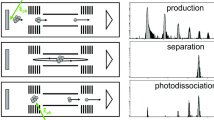60
molecules, whereas little or no coalescence was found in the nonreactive mixture. In the negative ion TOF channel the maximum peak of twice C60 coalescence by laser desorption was always located at masses greater than 120 carbon mass units, which is different from all previous reports. We suggest that the formation mechanism was due to strong interactions between the C60 molecules and silica particles or surface species such as the H or OH group existing in the matrix.
Similar content being viewed by others
Author information
Authors and Affiliations
Additional information
Received: 6 May 1996/Revised version: 22 July 1996
Rights and permissions
About this article
Cite this article
Zhu, L., Ong, P., Zhao, L. et al. Gas-phase aggregation of fullerenes by laser ablation of fullerenes in reactive and nonreactive matrices . Appl Phys B 66, 99–103 (1998). https://doi.org/10.1007/s003400050362
Issue Date:
DOI: https://doi.org/10.1007/s003400050362




